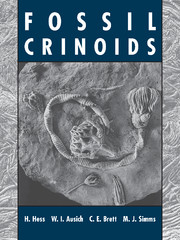Book contents
- Frontmatter
- Contents
- List of Contributors
- Acknowledgements
- Prelude
- Introduction
- GENERAL PART
- ASSEMBLAGES
- 6 Middle Ordovician Trenton Group of New York, USA
- 7 Middle Ordovician of the Lake Simcoe Area of Ontario, Canada
- 8 Upper Ordovician of the Cincinnati, Ohio, Area, USA
- 9 Silurian of Gotland, Sweden
- 10 Middle Silurian Rochester Shale of Western New York, USA, and Southern Ontario, Canada
- 11 Scyphocrinitids from the Silurian–Devonian Boundary of Morocco
- 12 Lower Devonian Manlius/Coeymans Formation of Central New York, USA
- 13 Lower Devonian Hunsrück Slate of Germany
- 14 Middle Devonian Windom Shale of Vincent, New York, USA
- 15 Middle Devonian Arkona Shale of Ontario, Canada, and Silica Shale of Ohio, USA
- 16 Lower Mississippian Hampton Formation at LeGrand, Iowa, USA
- 17 Lower Mississippian Burlington Limestone along the Mississippi River Valley in Iowa, Illinois, and Missouri, USA
- 18 Lower Mississippian Edwardsville Formation at Crawfordsville, Indiana, USA
- 19 Upper Pennsylvanian LaSalle Member, Bond Formation of Central Illinois, USA
- 20 Permian
- 21 Triassic Muschelkalk of Central Europe
- 22 Pentacrinites from the Lower Jurassic of the Dorset Coast of Southern England
- 23 Lower Jurassic Posidonia Shale of Southern Germany
- 24 Middle Jurassic of Southern England
- 25 Middle Jurassic of Northern Switzerland
- 26 Upper Jurassic Solnhofen Plattenkalk of Bavaria, Germany
- 27 Uintacrinus Beds of the Upper Cretaceous Niobrara Formation, Kansas, USA
- 28 Tertiary
- 29 Recent
- Appendix I Geological Time Table with Crinoid Assemblages
- Appendix II Glossary of Rocks
- Bibliography
- General Index
- Taxonomic Index
9 - Silurian of Gotland, Sweden
Published online by Cambridge University Press: 10 November 2010
- Frontmatter
- Contents
- List of Contributors
- Acknowledgements
- Prelude
- Introduction
- GENERAL PART
- ASSEMBLAGES
- 6 Middle Ordovician Trenton Group of New York, USA
- 7 Middle Ordovician of the Lake Simcoe Area of Ontario, Canada
- 8 Upper Ordovician of the Cincinnati, Ohio, Area, USA
- 9 Silurian of Gotland, Sweden
- 10 Middle Silurian Rochester Shale of Western New York, USA, and Southern Ontario, Canada
- 11 Scyphocrinitids from the Silurian–Devonian Boundary of Morocco
- 12 Lower Devonian Manlius/Coeymans Formation of Central New York, USA
- 13 Lower Devonian Hunsrück Slate of Germany
- 14 Middle Devonian Windom Shale of Vincent, New York, USA
- 15 Middle Devonian Arkona Shale of Ontario, Canada, and Silica Shale of Ohio, USA
- 16 Lower Mississippian Hampton Formation at LeGrand, Iowa, USA
- 17 Lower Mississippian Burlington Limestone along the Mississippi River Valley in Iowa, Illinois, and Missouri, USA
- 18 Lower Mississippian Edwardsville Formation at Crawfordsville, Indiana, USA
- 19 Upper Pennsylvanian LaSalle Member, Bond Formation of Central Illinois, USA
- 20 Permian
- 21 Triassic Muschelkalk of Central Europe
- 22 Pentacrinites from the Lower Jurassic of the Dorset Coast of Southern England
- 23 Lower Jurassic Posidonia Shale of Southern Germany
- 24 Middle Jurassic of Southern England
- 25 Middle Jurassic of Northern Switzerland
- 26 Upper Jurassic Solnhofen Plattenkalk of Bavaria, Germany
- 27 Uintacrinus Beds of the Upper Cretaceous Niobrara Formation, Kansas, USA
- 28 Tertiary
- 29 Recent
- Appendix I Geological Time Table with Crinoid Assemblages
- Appendix II Glossary of Rocks
- Bibliography
- General Index
- Taxonomic Index
Summary
STROMATOPOROID AND CORAL REEFS IN THE BALTIC SEA
The Swedish Island of Gotland is well known to vacationers, many of whom are also fossil collectors. They cannot miss the numerous fragments of crinoid stems spread over much of this picturesque island. The Silurian beds of Gotland, a succession of 13 stratigraphic units, range in age from Late Llandovery to Late Ludlow (around 420 million years before present) and reach a thickness of about 500 m (Fig. 96). The oldest rocks, the Lower Visby beds, are along the northwestern coast. They are composed of soft, bluish grey mudstones and contain nodules, lenses and layers of marly limestones. To the south and southeast, successively younger strata, including three elongated reef belts separated by flat mudstone areas, were laid down in a shallowing sea. The limestone reefs, predominantly composed of stromatoporoids, are surrounded by bedded, bioclastic sediments consisting largely of crinoid remains. Reefs started to grow as bioherms during the Early Wenlockian, the time of deposition of the Högklint beds. Shallowing seas and a reduced supply of terrigenous material favoured the growth of extensive reefs, which are exposed in cliffs on the northwestern coast of the island. The lower part of a typical Högklint reef was initiated by tabulate corals growing as a patch reef in deeper water on cross-bedded lenses of crinoid remains. Further reef growth was dominated by laminar stromatoporoids and topped by dome-shaped stromatoporoids, leading to a pronounced vertical profile of the structure (Kershaw 1993). These bioherms are comparable to modern reefs, their build-up being the result of the interplay between sedimentation and the growth of organisms. Reef growth continued into later Wenlock and Ludlow times.
- Type
- Chapter
- Information
- Fossil Crinoids , pp. 81 - 86Publisher: Cambridge University PressPrint publication year: 1999

